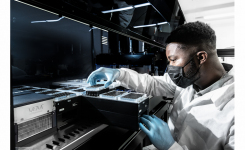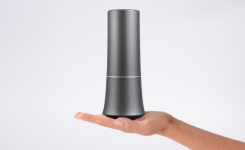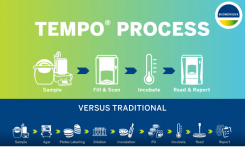Adaptable microscopy systems set new standards in ergonomy and efficiency
go back to news archives| With a host of features, the Olympus BX3 range establishes a new standard in clinical microscopy: Advanced LED Illumination The novel, true-colour LED illumination system has a unique wavelength profile, which provides a colour rendering index matching that of a halogen bulb with a daylight filter. This makes it ideal for high colour clarity across the entire range of brightfield stains, a capability not offered with standard LED illumination systems. Furthermore, the true-colour LED system is controlled by the Light Intensity Manager (LIM), which automatically adjusts the intensity to user-defined levels on each objective change, thus removing the need for manual adjustment and making screening more efficient. As well as offering this true-colour capability, users also benefit from the excellent life-span (approximately 20,000 hours) and minimal power consumption associated with LEDs, providing exceptionally low running costs and reduced downtime. Ergonomic genius In addition to the well established 'ergo-tube', the BX3 microscopes are available with the world's first tilting/telescopic/lifting observation tube that provides adjustment in three dimensions: eyepiece tilt -3° to +27º, tube extension (backwards/forwards) of 55mm, and lifting of 45mm. The BX46 also features an ultra-low (only 128mm above the desk surface) fixed low-torque stage with ergo-grip controls. This ensures that the movements and force required by the operator are minimised as their arms can remain on the desk at all times; even placing a sample on the stage requires very little effort. As a result of these features, each user can set-up the microscope to match their ideal, ergonomically-correct posture, rather than adapting themselves to the microscope. This further increases screening efficiency as the microscope is more comfortable to use and therefore induces less musculo-skeletal stress on the user. Optically superior As well as integrating the market leading UIS2 optical components, the BX3 range has also been optically optimised to improve workflows. For example, the new wide-range condenser accommodates magnifications from 2-100x without requiring a swing-top lens. This cuts out one of the common and time-consuming steps of microscope screening, offering substantial efficiency improvements. Automatic read-out The BX3 range also features coded nosepiece and mirror turret modules enabling users to automatically record and share microscope magnification and setting information for comparing, measuring and scaling images. This readout provides the correct meta-data automatically to the Olympus labSens software packages, as well as the standalone DP21 digital imaging camera, ensuring no mistakes or scaling errors are made when documenting images. Future proof The BX3 range of clinical microscopes from Olympus is ideal for covering all the current clinical requirements and protocols. More importantly, it is also ready for the future, whatever that may bring. The modular nature of BX43 ensures that it can facilitate multiple capabilities, including excellent fluorescence imaging, for which, the incorporation of a novel and unique fly-eye lens system provides unmatched illumination homogeneity. The full range of Olympus digital imaging cameras are available for the BX3 enabling every imaging requirement to be met. Furthermore, a series of motorisation options, combined with the labSens software packages, ensure that the user can automate just the features they'd like to. As a result the perfect imaging system for every eventuality can be created with ease at any point in time, making your lab future-ready. Consultancy and training Consultancy and training are essential functions in the clinical environment and Olympus is at the forefront of providing excellent efficiency in this area, offering customisable, dual-observation and multi-discussion units for laboratory conferencing. In addition, if fitted with a digital imaging camera and the labSens software, the BX3 microscopes can essentially act as a netcam. Using standard TCP/IP protocols the labSens 'NetCam solution' enables the transfer of live and stored images throughout the network from one source to any number of destinations for teaching, mentoring or supervision. Advanced imaging The BX3 clinical microscopes form part of the broader range of highly versatile Olympus BX3 upright microscope systems, with the research focused BX53 and the fully motorised BX63. In addition, the VS110 provides advanced virtual slide capabilities, scanning entire slides at high resolution in X, Y and Z and enabling them to be navigated on screen as if actually reviewing the original slide. |
NOTE: This item is from our 'historic' database and
may contain information which is not up to date.
Source : Olympus Life and Material Science Europa GMBH View Company Information
Posted on October 25, 2010

















